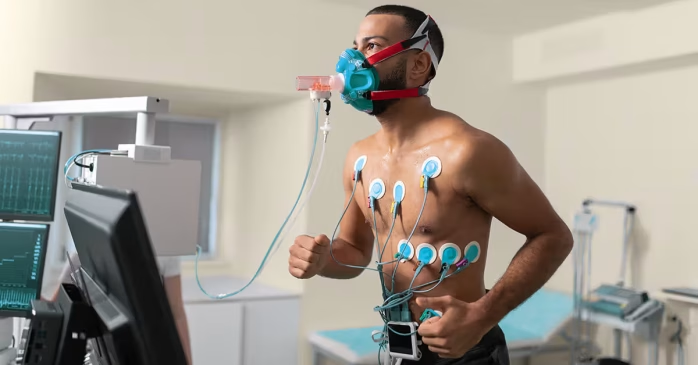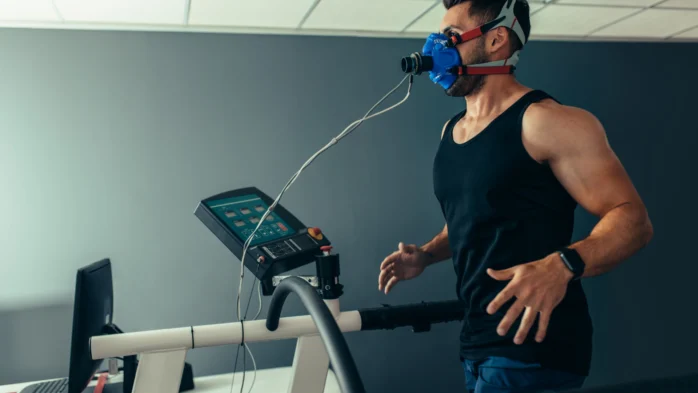For athletes, fitness enthusiasts, and anyone looking to improve their health, VO₂ max is a key indicator of cardiovascular endurance and aerobic capacity. It measures how efficiently your body uses oxygen during intense exercise — in other words, how well your heart, lungs, and muscles work together when you’re pushing your limits. With access to advanced VO₂ max testing applications, understanding your results is easier than ever, helping you set realistic goals and track your progress with precision.
Contents
What is VO₂ Max?

VO₂ max, short for “maximal oxygen uptake,” represents the maximum amount of oxygen your body can consume per minute, measured in millilitres per kilogram of body weight (ml/kg/min). The higher your VO₂ max, the more oxygen your body can use — which typically means better endurance and aerobic performance.
This measure isn’t just for elite athletes – VO₂ max testing offers valuable insights for anyone wanting to improve their fitness, whether it’s for running a marathon, cycling faster, or simply feeling more energised in daily life.
Your VO₂ max is influenced by several factors, including age, sex, genetics, body composition, and training background. While you can’t control your genetics, your lifestyle and training habits can significantly influence your score over time.
What’s Considered a Good VO₂ Max Score?
“Good” VO₂ max scores vary depending on age, gender, and fitness level. Generally, the younger and more active you are, the higher your VO₂ max tends to be. Here’s a simplified breakdown based on typical population averages:
| Category | Men (ml/kg/min) | Women (ml/kg/min) |
| Excellent | 60+ | 55+ |
| Good | 50–59 | 45–54 |
| Above Average | 40–49 | 35–44 |
| Average | 30–39 | 25–34 |
| Below Average | 20–29 | 20–24 |
| Poor | <20 | <20 |
These numbers are only a guide (for example, a VO₂ max of 50 might be excellent for someone in their 40s but only average for a professional triathlete). The key is to focus on personal improvement over time rather than comparing yourself to others.
If you’re using a smartwatch or fitness tracker, keep in mind that these readings are estimates. While they can help you observe trends, professional VO₂ max testing provides far more accurate and actionable data.
Why VO₂ Max Matters
A higher VO₂ max means your body is better at transporting and utilising oxygen, which translates to improved stamina, faster recovery, and overall heart health. It’s a powerful indicator of both athletic potential and longevity — research shows that people with higher VO₂ max scores tend to live longer and experience fewer cardiovascular issues.
In fact, studies have found that VO₂ max is a stronger predictor of long-term health and survival than many traditional markers such as cholesterol or blood pressure. That’s because it reflects the efficiency of your entire cardiorespiratory system — the foundation of all physical performance.
Here are some of the key benefits of improving your VO₂ max:
- Enhanced endurance: You can sustain higher levels of exertion for longer periods.
- Faster recovery: Improved oxygen delivery helps clear metabolic waste faster.
- Better performance: Runners, cyclists, swimmers, and even team sport athletes benefit from improved aerobic efficiency.
- Healthier heart and lungs: Regular aerobic training strengthens your cardiovascular and respiratory systems.
- Increased energy: Everyday activities become easier and less fatiguing when your body is more efficient at using oxygen.
How VO₂ Max is Measured
There are two main ways to measure VO₂ max: direct and indirect testing.
- Direct VO₂ Max Testing
This method is typically performed in a lab or sports science facility – it involves running or cycling on a treadmill or ergometer while wearing a mask that measures your oxygen intake and carbon dioxide output. The test gradually increases in intensity until you reach your maximum effort. Direct testing is considered the “gold standard” for accuracy. - Indirect or Predictive Testing
Many fitness watches, smart devices, and mobile apps estimate VO₂ max based on your heart rate, pace, and workout data. While these estimates can’t match lab precision, they’re convenient and allow for continuous tracking. Over time, the data provides useful insights into how your fitness is progressing.
If you want the most accurate assessment — particularly for competition training or medical purposes — professional VO₂ max testing is recommended.
How to Improve Your VO₂ Max
The great news is that VO₂ max is trainable; you can improve it through consistent, structured exercise and smart recovery practices. Some proven methods include:
- High-Intensity Interval Training (HIIT): Alternating between intense bursts and recovery periods challenges your cardiovascular system efficiently. For instance, sprinting for 30 seconds followed by 90 seconds of light jogging, repeated 6–8 times, can dramatically improve aerobic capacity.
- Steady-State Cardio: Long, moderate-intensity sessions such as distance running, swimming, or cycling help build a strong aerobic base.
- Fartlek Training: A mix of continuous and interval training, Fartlek (“speed play”) involves varying your pace throughout a workout to keep your heart rate fluctuating.
- Altitude Training: Exercising in low-oxygen environments can stimulate red blood cell production, enhancing oxygen delivery when you return to sea level.
- Strength Training: Building lean muscle can enhance oxygen utilisation efficiency, particularly in muscles used during endurance sports.
- Proper Recovery: Rest, sleep, and balanced nutrition play a critical role in maximising your gains. Overtraining can actually reduce VO₂ max by increasing fatigue and inflammation.
Remember that improvements take time — most people can expect a 5–20% increase in VO₂ max after several months of structured training.
Common Factors That Affect VO₂ Max
Your VO₂ max can fluctuate due to various lifestyle, environmental, and physiological factors:
- Age: VO₂ max naturally declines with age, typically by 1% per year after the age of 30. Regular training helps slow this decline.
- Gender: Men usually have higher VO₂ max values due to greater muscle mass and haemoglobin levels, though fit women often outperform sedentary men.
- Body composition: Excess body fat can reduce VO₂ max when measured relative to body weight.
- Altitude: Oxygen availability decreases at higher elevations, lowering VO₂ max temporarily.
- Temperature and hydration: Hot, humid environments and dehydration can increase cardiovascular strain and reduce performance.
Understanding these factors helps you interpret your test results accurately and avoid unnecessary worry about small variations.
Making Sense of Your Results

Your VO₂ max score provides a snapshot of your current aerobic fitness — but the real value lies in tracking how it changes over time. Whether you’re aiming to boost performance, recover from injury, or simply gauge your health status, professional VO₂ max testing offers objective data to guide your training and lifestyle decisions.
It’s also worth pairing your VO₂ max data with other metrics such as heart rate variability (HRV), resting heart rate, and lactate threshold. Together, these measures provide a more complete picture of your fitness and recovery readiness.
For everyday athletes, setting incremental goals is key. Instead of chasing arbitrary numbers, focus on consistent training improvements — such as running a familiar route faster or feeling less fatigued at a given pace. Over time, your VO₂ max will naturally increase as your body adapts.
Understanding your VO₂ max results is about more than just numbers — it’s about recognising your body’s capacity and using that insight to grow stronger, fitter, and healthier
With modern VO₂ max testing applications, you can benchmark your performance, identify areas for improvement, and take the guesswork out of your fitness journey. By combining data-driven insights with consistent training and healthy habits, you’ll not only enhance your athletic performance but also improve your long-term wellbeing. Whether you’re an elite competitor or simply striving to live a more active life, knowing your VO₂ max — and working to improve it — is one of the smartest investments you can make in your health.
















